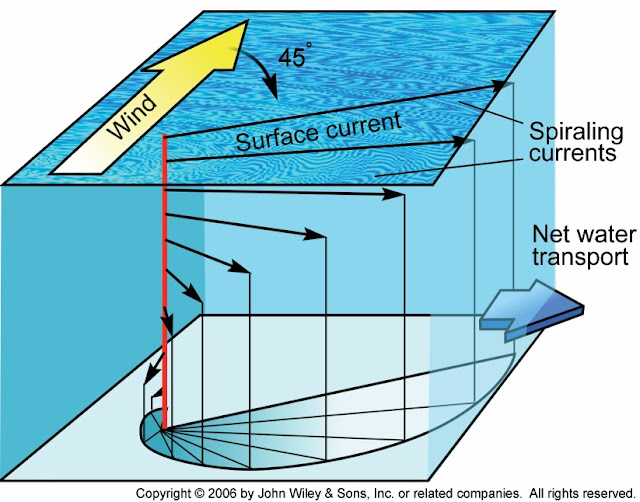There’s an odd phenomenon in geophysical fluid dynamics
called “Ekman transport”, named for fluid dynamicist Vagn Walfrid Ekman, where
wind blowing across the ocean surface causes the water to flow, not in the same
direction with the wind, but at an angle, as a result of the Coriolis effect.
In the northern hemisphere, the flow of water is diverted to the right of the
wind; in the southern hemisphere, it is diverted to the left.
When one layer of fluid is moving across another, it transfers some of its momentum through friction. This transfer force is called “shear stress”, referring to how fluid is dragged along by contact with fluid already in motion, but more slowly, creating relative movement within the fluid itself. (This relative motion is called shear.) Momentum transfer via shear stress happens within the atmosphere, it happens between the atmosphere and the ocean surface, and it happens within the ocean. One layer of air or water pulls the layer beneath it along via friction.
However, due to the rotation of the planet, on a large scale
of miles, the layer of air or water pulled along does not travel in the same
direction as the overlying layer. The lower layer is diverted to the right in
the northern hemisphere, and to the left in the southern. This has three main
effects.
The first effect: in the northern hemisphere, water on the ocean surface tends to move, in general, at an angle 45° to the right of the direction of the wind (45° to the left in the southern hemisphere). As you go deeper down into the water column, the process repeats itself, of every layer of water successively being pushed 45° to the right (left), though at slower and slower speeds, since the transfer of momentum is not perfectly efficient.
The second effect: net transport of ocean water, when the wind blows, is 90° to the right (left) in the northern (southern) hemisphere. This is called Ekman transport. The third effect: successive layers of water being pushed to the right (left) of the layer above creates a spiral of currents, driven ultimately by the wind on the ocean surface. This is called an Ekman spiral.
***The Ekman spiral can be viewed in the atmosphere as well,
though incompletely. Next time you’re outdoors and it’s partly cloudy out,
spend a minute looking closely at the direction of travel of clouds at
different altitudes. They’re not necessarily the same. The air at different
altitudes can be, and usually is, moving in quite different directions, at
different speeds.
Tomorrow; upwelling.
Be brave, and be well.








No comments:
Post a Comment